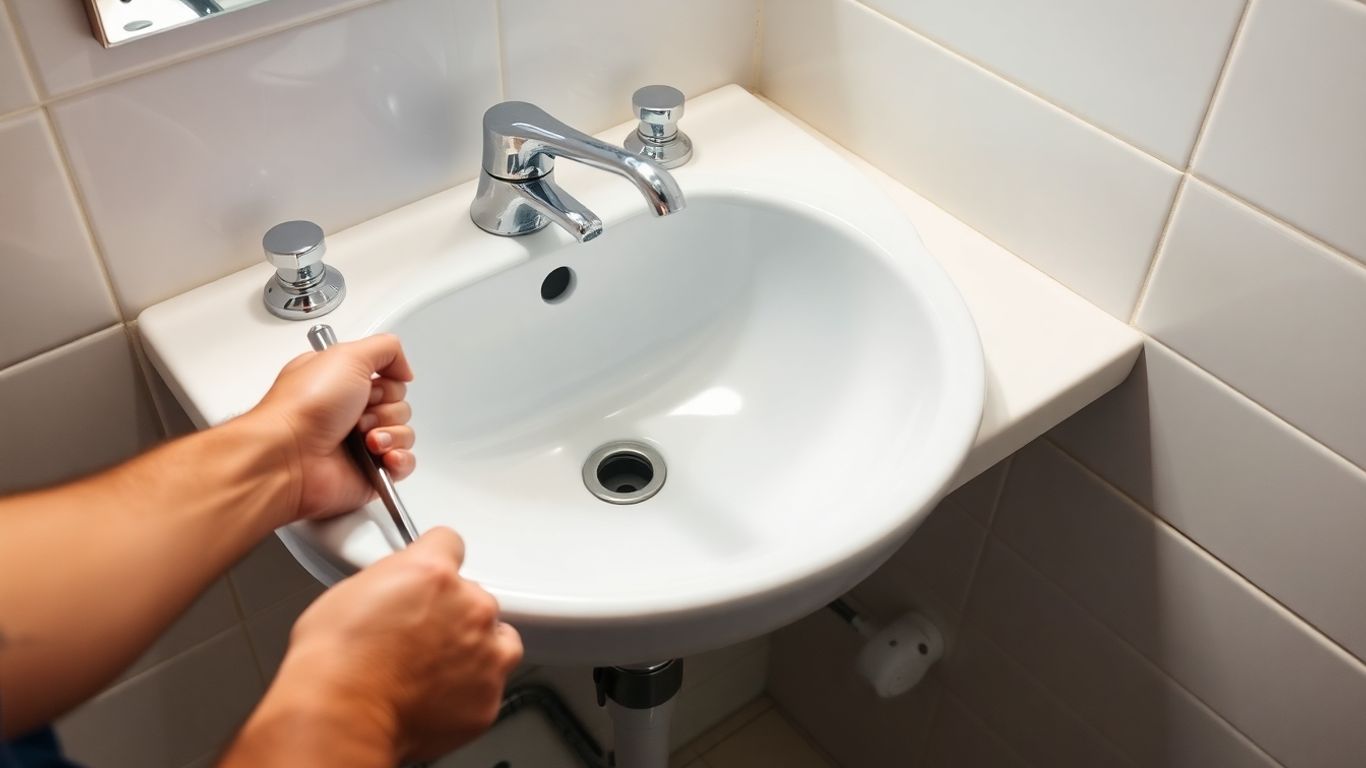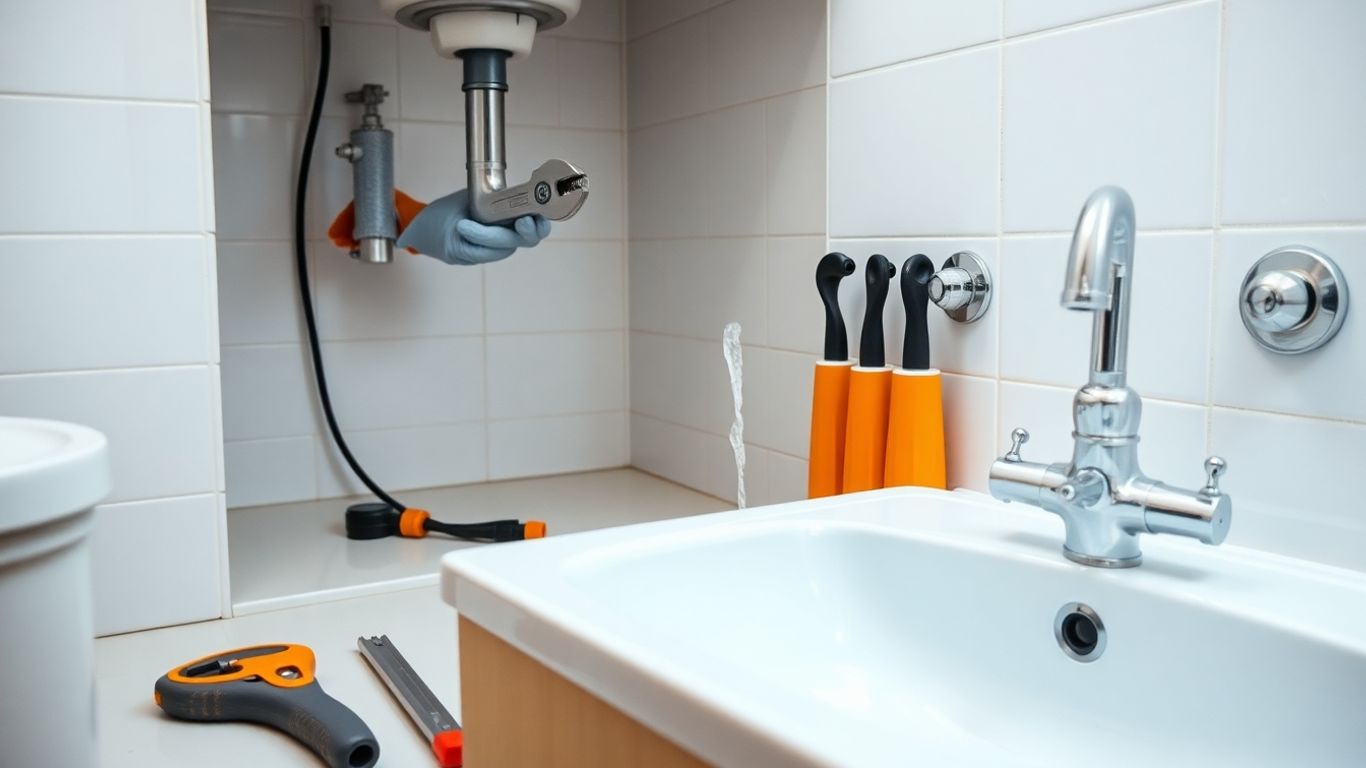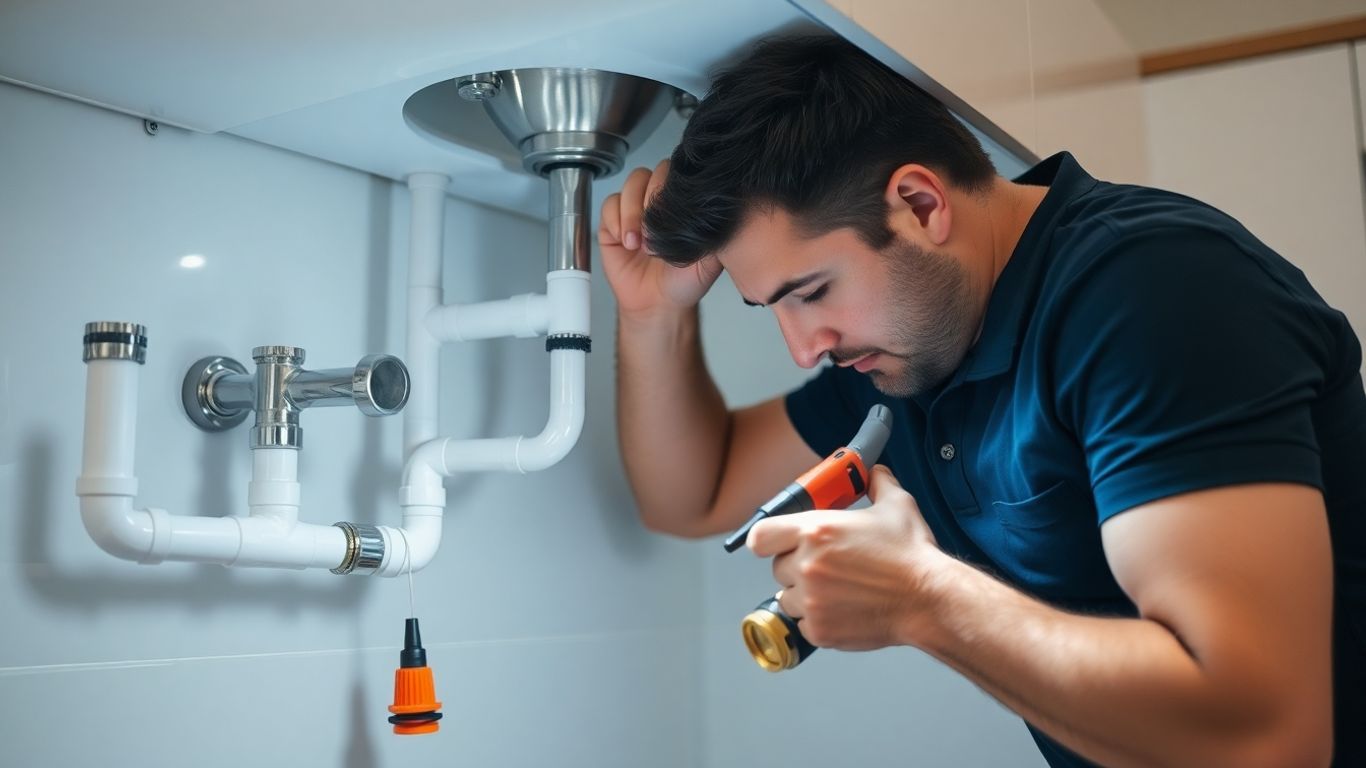- October 8, 2025
- - In category: Blog
Plumbing is one of those things you barely notice until something stops working. Suddenly, there’s water where it shouldn’t be, or nothing comes out of the tap at all. Learning how to maintain home plumbing systems doesn’t have to be complicated. With a little patience and a few simple tools, you can keep things running smoothly and avoid the panic of a surprise leak or clog. This guide breaks down the basics so you can feel a bit more confident the next time you hear a drip or see water pooling under the sink.
Key Takeaways
- Get familiar with your home’s main plumbing parts—like shut-off valves, pipes, and fixtures.
- Keep a basic set of plumbing tools handy for small fixes and emergencies.
- Check water pressure regularly and clean faucet aerators to keep the flow steady.
- Don’t put grease, wipes, or large scraps down the drain to help prevent clogs.
- Do a quick check for leaks or drips every season to catch problems early.
Understanding Your Home Plumbing System In Ottawa
Plumbing is one part of the house most people don’t really think about—until the toilet won’t flush or the shower spits out cold water. Knowing how your home plumbing system works can help you catch problems early and avoid costly repairs. Here are the major parts and what they actually do:
- Water Supply Lines: These bring fresh, pressurised water from your municipal system (or well) into your house. You’ll often hear terms like “house water pipe”—it’s basically the highway that delivers water to every faucet, shower, and appliance needing water.
- Drain, Waste, and Vent (DWV) System: After water is used, the spent water needs to get out. Three kinds of pipes do this job. Drains move water and waste away from sinks, tubs, and toilets. Large waste pipes carry everything to the sewer or septic tank. Vents let air in to keep your drains flowing smoothly, so there’s no vacuum or weird gurgling.
- Water Heater: This is the appliance keeping those morning showers bearable in winter. It does what its name says—heats water for the whole home, from the bathroom sink to dishwashers. A failing water heater can cause anything from cold showers to leaks on your basement floor.
- Fixtures and Appliances: Think of every device that connects to your pipes: sinks, toilets, bathtubs, dishwashers, and washing machines. Anything hooked up to a pipe is part of the system.
| Component | Main Job | Materials (Common) |
| House Water Pipe | Delivers fresh water | Copper, PEX, PVC |
| Drain Pipes | Removes used water/waste | PVC, ABS, old plumbing: cast iron |
| Water Heater | Provides hot water | Steel tank, copper pipes |
| Fixtures | Use/distribute water to users | Various (porcelain, brass) |
Even with old plumbing, a house’s network of pipes is meant to work quietly in the background, but small leaks or slow drains deserve attention—they’re usually the first warning sign something’s up.
When you walk around your place, take note of where key things like the water main shut-off valve and your water heater are. If you’ve got old plumbing, you might find pipes made of iron or even lead—worth noting for safety and insurance reasons.
Finally, don’t assume everything in the system lasts forever. Pipes corrode, water heaters fail, and sometimes the only sign is a slow leak under a sink. Pay attention to these moving parts and get familiar with things now, not in an emergency.
Essential Tools for Plumbing System Maintenance In Ottawa
When it comes to DIY plumbing care for beginners, having the right tools available can make repairs less stressful and definitely more effective. If you want easy ways to keep pipes in good condition or handle simple faucet repairs, you don’t need a speciality toolbox—just a few core items. Most things on a home plumbing inspection checklist can be handled with basic gear, and here are some must-haves:
- Adjustable wrench: Vital for tightening or loosening nuts and bolts on faucets, supply lines, and under sinks.
- Pipe wrench: Heavy, sturdy, and made for stubborn fittings, especially when tackling leak repair or frozen pipes.
- Plunger: Both a cup plunger (for sinks) and a flange plunger (for toilets) will come in handy for blockages.
- Plumber’s tape (Teflon): Wrap this around threaded pipe joints during assembly to help prevent leaks.
- Drain snake (also called an auger): Unclogs showers, tubs, and sinks without harsh chemicals (better for your pipes).
- Basin wrench: Its awkward shape is perfect for those hard-to-reach nuts behind sinks during sink repair.
- Bucket/absorbent towels: For catching leaks, draining pipes, or just cleaning up during plumbing repair.
You can find most of these at the local hardware store, and honestly, you’ll use them more than you think. Here’s a basic table to help you see what each tool is best for:
| Tool | Main Uses | Typical Plumbing Tasks |
| Adjustable wrench | Tightening/loosening fittings | Faucet repair, Pipe Lining |
| Pipe wrench | Gripping metal pipes | Leak repair, Frozen Pipes |
| Plunger | Removing clogs | Sink, Toilet blockages |
| Plumber’s tape | Sealing threaded connections | Leak prevention, plumbing repair |
| Drain snake | Breaking up clogs | Unblocking drains |
| Basin wrench | Hard-to-reach fasteners | Sink repair, faucet installations |
| Bucket/Towels | Catching water, cleanup | Minor leaks, draining tasks |
With a handful of basic tools and a bit of patience, most routine DIY fixes—like tightening a leaky faucet or unclogging a drain—are well within reach for homeowners. For bigger projects like pipe lining or issues that never seem to get fixed properly, we recommend a good plumber in Ottawa.
Whether you’re looking for plumbing maintenance tips for homeowners or just want to avoid a midnight sink crisis, these tools are your starting point. Regular checks and prompt repairs will go a long way to keep your plumbing running smoothly.
Maintaining Water Pressure and Flow
Water pressure that’s either too high or too low can make daily tasks difficult, and over time, it might even damage your pipes and appliances. Keeping pressure and flow at a steady, healthy level takes regular checks and a little troubleshooting when things seem off. You should never ignore sudden changes in flow or pressure at your faucets, showers, or washing machine.
Here’s what you can do if you notice issues with pressure or flow:
- Check all the isolation valves throughout your home to make sure none are partially closed or stuck.
- Clean aerators and showerheads. Mineral buildup, especially if you don’t have a Water Softener, can shrink openings and restrict water.
- Inspect exposed pipes for any damp spots or visible leaks—little leaks add up to big drops in pressure fast.
- If you have a Water Treatment System, keep your Drinking Water Safe, make sure it is serviced and filters are replaced. Sediment or blocked filters will kill the flow throughout the house.
You can test your household water pressure with a simple gauge from a hardware store. Attach it to a hose bib and note the reading:
| Pressure (PSI) | What It Means |
| Below 40 | Too low for many uses |
| 40–60 | Normal/Ideal for most homes |
| Over 80 | Risk of pipe/appliance damage |
Sometimes, water pressure drops because the main shutoff valve isn’t fully open after a repair, or because your city’s water supply changes. Call your local utility if pressure problems hit the whole neighbourhood.
Keeping the right water pressure and good flow isn’t just about comfort—it helps your plumbing last longer and protects your drinking water system. And if you ever feel lost, don’t be afraid to call a pro to investigate stubborn issues.
Preventing Clogs and Blockages
 Nothing grinds your day to a halt faster than a slow-draining sink or backed-up toilet. It might not sound glamorous, but preventing common plumbing issues like clogs and blockages really just takes a few steady habits and a little know-how. The best way to keep your pipes clear is regular, basic maintenance and paying close attention to what you allow down the drain.
Nothing grinds your day to a halt faster than a slow-draining sink or backed-up toilet. It might not sound glamorous, but preventing common plumbing issues like clogs and blockages really just takes a few steady habits and a little know-how. The best way to keep your pipes clear is regular, basic maintenance and paying close attention to what you allow down the drain.
Try these practical steps to keep blockages at bay:
- Use mesh drain screens in sinks, tubs, and showers. Clean them often to trap hair, food, and other debris before it slips into your plumbing.
- Never pour grease, oil, or coffee grounds down the drain. Grease solidifies and sticks to pipe walls, while coffee grounds clump together and won’t break down.
- Practice good toilet habits. Only flush waste and toilet paper—no wipes, paper towels, or feminine products.
- Once a month, flush your drains with a pot of hot water to help melt away residue inside the pipes.
- Consider a routine of natural drain cleaning: pour half a cup of baking soda, followed by a cup of vinegar down the drain, wait 30 minutes, then flush with hot water. It gently clears minor buildup without damaging pipes.
Drain Cleaning: Do’s and Don’ts Table
| Do | Don’t |
| Use a plunger for minor clogs | Use harsh chemical drain cleaners |
| Snake the drain for stubborn clogs | Neglect regular drain maintenance |
| Clean drain covers regularly | Pour grease or oil down the sink |
| Use baking soda & vinegar | Flush wipes or hygiene products |
Staying on top of basic, routine drain cleaning will help avoid emergency calls and expensive repairs—saving a lot of hassle in the long run.
Seasonal Plumbing Maintenance Tips In Ottawa
When the seasons change, your plumbing needs a little extra attention. Here are some ways you can help your system out—especially if you want to keep preventing common plumbing issues:
- In fall and winter, insulate exposed pipes in unheated areas, like garages or crawl spaces, to prevent freezing and bursting.
- Clear out gutters and downspouts in autumn to ensure proper water flow and to help avoid unwanted backups near your home’s foundation.
- Check outdoor faucets and garden hoses before the first frost. Drain any water and shut them off if possible.
- Spring is a great time to look for leaks that may have formed during winter, especially under sinks and around the water heater.
- During summer, if you travel, shut off the main water valve and drain the system to avoid any nasty surprises when you return.
Remember—just a little prevention and regular maintenance can make a world of difference when it comes to keeping your home’s plumbing running smoothly and stress-free.
Conclusion
Finishing up your plumbing journey, if you’re anything like me, you probably started a little nervous about tinkering with pipes and fixtures at home. The truth is, learning some handy skills and paying attention to details makes keeping your plumbing in shape much less intimidating. A little regular attention can save you major headaches (and money) down the road.
Here are a few things to keep in mind as you move forward:
- Take time to familiarise yourself with all visible pipes and shut-off valves—one day, you’ll be glad you did.
- Regularly check for leaks by inspecting exposed pipes under sinks and around appliances, which helps prevent costly damage.
- Don’t ignore slow drains, even if they seem minor at first—the sooner you clear out blockages, the better.
- Always keep basic tools, like a wrench and a bucket, somewhere easy to find.
- Maintenance isn’t just an annual thing. Get in the habit of checking under the sink or in the basement every so often.
Many problems pop up quietly and can turn serious fast if left alone; early fixes are always easier and cheaper than dealing with big disasters.
It does take some time to get comfortable handling plumbing basics. But with these habits, you’ll feel more at ease tackling repairs or spotting trouble before it spirals. Your pipes—and your wallet—will thank you.
Thanks for reading! If you have any plumbing problems or just want to ask a question, don’t wait. Visit our website today and see how Clean Stream Plumbing can help you. We are ready to make things easy for you, so reach out now!
Frequently Asked Questions
How often should I check my plumbing for leaks?
It’s a good idea to check your plumbing for leaks every few months. Look under sinks and around toilets for any signs of water, like puddles or damp spots. Catching leaks early can help prevent bigger problems later.
What can I do to prevent my drains from clogging?
To keep your drains clear, don’t pour grease or oil down the sink and use drain covers to catch hair and food. Run hot water down the drain after each use to help clear away buildup. Avoid flushing anything except toilet paper.
Why is my water pressure low?
Low water pressure can be caused by clogged pipes, a closed shut-off valve, or buildup in your faucet aerator. Try cleaning the aerator and checking for leaks. If the problem continues, you may need to call a plumber to look at your pipes.
What tools should every homeowner have for basic plumbing fixes?
Every homeowner should have a plunger, an adjustable wrench, plumber’s tape, a bucket, and a pipe wrench. These tools can help you handle most small plumbing jobs, like fixing leaks or clearing clogs.
How do I find the main water shut-off valve in my house?
The main water shut-off valve is usually found where the water line enters your home, often in the basement, garage, or near an outside wall. Knowing where this is can help you quickly stop water flow in case of a leak.
When should I call a professional plumber?
Call a professional plumber if you have a leak you can’t stop, a clog that won’t clear, or if you notice water damage. It’s also smart to call for help if you feel unsure about fixing a plumbing issue yourself.



